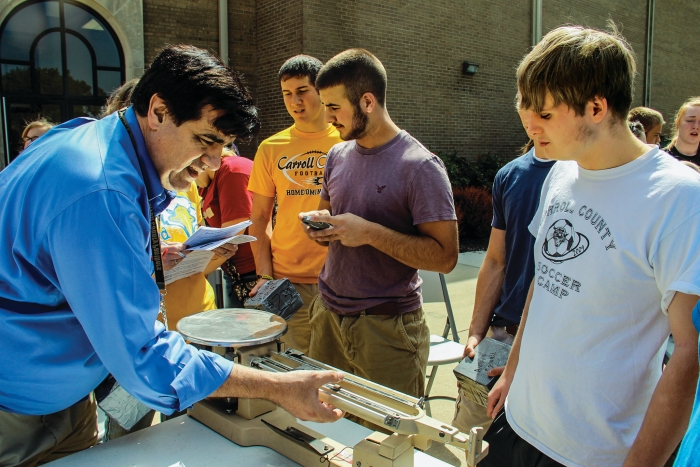Advertisement
Grab your lab coat. Let's get started
Welcome!
Welcome!
Create an account below to get 6 C&EN articles per month, receive newsletters and more - all free.
It seems this is your first time logging in online. Please enter the following information to continue.
As an ACS member you automatically get access to this site. All we need is few more details to create your reading experience.
Not you? Sign in with a different account.
Not you? Sign in with a different account.
ERROR 1
ERROR 1
ERROR 2
ERROR 2
ERROR 2
ERROR 2
ERROR 2
Password and Confirm password must match.
If you have an ACS member number, please enter it here so we can link this account to your membership. (optional)
ERROR 2
ACS values your privacy. By submitting your information, you are gaining access to C&EN and subscribing to our weekly newsletter. We use the information you provide to make your reading experience better, and we will never sell your data to third party members.
Business
Companies That Care
Three top firms with ties to chemistry prove that large doesn’t have to mean impersonal
by Laura Cassiday
October 13, 2014
| A version of this story appeared in
Volume 92, Issue 41

Who says big companies are cold, heartless behemoths, where employees are numbers and every decision is based on the bottom line? The three companies highlighted in this year’s C&EN profile of top companies for chemists are out to dispel this perception. Although large, these companies foster collaboration and the building of communities within the larger corporate community, making every employee feel like a valued member of a team striving for a common goal. The companies recognize that employees are more than just their job titles, giving them the flexibility to fulfill personal as well as professional obligations.
STANDOUTS
Top Chemistry-Related Companies To Work For
100 BEST COMPANIES TO WORK FOR (FORTUNE, JAN. 16, 2014)
6. Genentech, South San Francisco
22. W. L. Gore & Associates, Newark, Del.
26. NuStar Energy, San Antonio
30. St. Jude Children’s Research Hospital, Memphis
42. Stryker, Kalamazoo, Mich.
51. Chesapeake Energy, Oklahoma City
53. Mayo Clinic, Rochester, Minn.
56. Devon Energy, Oklahoma City
64. General Mills, Minneapolis
68. Roche Diagnostics, Indianapolis
72. Novo Nordisk, Plainsboro, N.J.
76. Mars, McLean, Va.
97. EOG Resources, Houston
100 BEST COMPANIES FOR WORKING MOTHERS (WORKING MOTHER, SEPT. 16, 2014)
Abbott, Abbott Park, Ill.
AbbVie, North Chicago
AstraZeneca, Wilmington, Del.
Boehringer Ingelheim USA, Ridgefield, Conn.
Bristol-Myers Squibb, New York City
Colgate-Palmolive, New York City
Dow Corning, Midland, Mich.
DuPont, Wilmington, Del.
Eli Lilly & Co., Indianapolis
General Electric, Fairfield, Conn.
Genentech, South San Francisco
General Mills, Minneapolis
Johnson & Johnson, New Brunswick, N.J.
Kellogg, Battle Creek, Mich.
Merck & Co., Whitehouse Station, N.J.
Novartis Pharmaceuticals, East Hanover, N.J.
Procter & Gamble, Cincinnati
Roche Diagnostics, Indianapolis
S. C. Johnson, Racine, Wis.
Takeda, Deerfield, Ill.
Yale University, New Haven
Zoetis, Florham Park, N.J.
C&EN has selected three companies—Genentech, Novo Nordisk, and AstraZeneca—from chemistry-related firms that made Fortune’s “100 Best Companies to Work For” or Working Mother’s “100 Best Companies” in 2014. Because they are large, each of these companies offers many job opportunities for chemists. Like other companies on these two lists, they aim to attract and retain bright, passionate scientists by offering stimulating work environments and excellent benefits packages.
Genentech, a biotech company with headquarters in South San Francisco, is a perennial favorite of “top companies” lists, making both the Fortune and Working Mother lists for the 16th time in 2014. Genentech was founded in 1976 by venture capitalist Robert A. Swanson and biochemist Herbert W. Boyer, a pioneer in the field of recombinant DNA technology.
The firm, which became a subsidiary of Roche in 2009, now has 35 medicines on the market and 44 therapies in the pipeline for the treatment of conditions as diverse as cancer and schizophrenia.
Genentech has about 12,000 employees, with 1,200 scientists (bachelor’s, master’s, and Ph.D. degrees) and 100 postdocs in the research and early-development arm of the organization. Additional opportunities exist for chemists in technical operations such as drug manufacturing and quality control.
For Mary Cromwell, a biophysical chemist, the opportunity to merge her interests in biology and physical chemistry was what initially attracted her to the pharmaceutical research and development group at Genentech. “When you’re a biophysical chemist, you’re interested in a lot of scientific disciplines,” she says. “I read a job description that looked like it fit my interests perfectly. I was intrigued that there was a company doing this kind of work, where I could take what I had learned in grad school and apply it to a real-life situation.”
Now, 25 years later, Cromwell works in a management role as head of global bio-manufacturing sciences and technology and packaging development. Throughout her career at Genentech, she has enjoyed the cross-disciplinary approach of the company. “I’ve worked with biologists, engineers, organic chemists, physical chemists, analytical chemists, even food chemists,” she says. “At Genentech, we look across various disciplines and maybe even other industries for the expertise that we need.” Cromwell notes that one of her current group members came from the paint industry, where he had expertise in materials science that was relevant to product packaging.
Although the biotech company encourages teamwork, each member of the team is “highly self-motivated,” Cromwell says. “The people tend to want to solve puzzles on their own, not because somebody’s asking them to solve a problem.” Micromanagement by supervisors “doesn’t go over well,” she laughs.

In addition to the scientific stimulation, Genentech’s benefits package “plays a key role in attracting and retaining talent,” says Nadine Pinell, senior manager of external communications. “Genentech is recognized for providing our employees with some of the most competitive and comprehensive benefits in the country. Our benefits and programs are convenient and easy to use so that employees can focus on the science and the patients.”
The package includes family-friendly benefits, such as on-site child care. Seventy-five percent of employees use a flextime schedule, and 50% telecommute. Opportunities for job sharing also exist. Although Cromwell’s children are now grown, she remembers how helpful these benefits were to her family. “I attended many meetings via teleconference so that I could take care of my kids’ needs,” she says. “There was a lot of flexibility about how I could meet the demands of my work schedule while also meeting the demands of being a mother.”
The company also offers activities and groups to build camaraderie among employees and connect those with similar interests. Some groups, such as a biking club, are recreational, whereas others foster professional or personal development. For example, a group called NextGen, primarily for younger people entering the workforce, offers professional development seminars, mentoring and leadership programs, and networking opportunities.
Each year during Genentech Gives Back Week, employees have the opportunity to raise money for charities and volunteer with local and national nonprofit groups of their choice during working hours. In 2014, 5,300 employees volunteered for more than 250 community projects and raised more than $236,000 for local charities.
Novo Nordisk, the world’s largest diabetes care company and leading producer of insulin, traces its roots back to Denmark in the 1920s. In 1923, August Krogh, a Nobel Prize-winning professor at the University of Copenhagen, decided to start producing a revolutionary new medicine called insulin. Inspired by his wife’s type 2 diabetes, a condition often fatal at the time, Krogh founded Nordisk Insulinlaboratorium. The firm initially extracted insulin from bovine pancreas, then pig pancreas, and in 1987 began producing the human hormone from genetically engineered yeast cells. In 1989, Nordisk merged with a competing Danish firm established in 1925, Novo Terapeutisk Laboratorium, to create Novo Nordisk.

In addition to selling modern long-lasting insulin and other diabetes drugs, Novo Nordisk markets glucose-monitoring devices and insulin injection pens and pumps. It also offers products for growth hormone therapy, hormone replacement therapy, and hemophilia treatment. Novo Nordisk currently has 31 products on the market, with 17 drugs in the pipeline.
The company’s world headquarters are in Bagsværd, Denmark, and its 40,700 employees work in 75 countries. U.S. headquarters are in Plainsboro, N.J., with a R&D center in Seattle and an insulin production facility in Clayton, N.C. Total U.S. employees number 5,143.
With a company so large and diverse, establishing a global company culture seems daunting, if not impossible. To help meet this challenge, management has issued a booklet called “The Novo Nordisk Way,” which is intended to guide the decisions and actions of employees. Essential to the Novo Nordisk way is the triple bottom line, which involves balancing financial, social, and environmental considerations. Facilitators conduct visits to company sites to highlight best practices, as well as identify areas that need improvement.
Raymond Couch is a quality-control chemist at the Novo Nordisk production facility in Clayton. He analyzes the stability and other parameters of insulin manufactured at the plant, and he also helps calibrate the high-performance liquid chromatography systems. “The quality-control department is very well organized and utilizes a standard [that is] set across the whole company,” says Couch. “Process improvement is a daily thought.”
Couch says that the reputation and stability of the company are what attracted him to Novo Nordisk, which he describes as a family-friendly workplace. “The facility is recognized for its parental leave—which includes fathers—and the promotion of family-focused activities such as the Juvenile Diabetes Research Foundation Walk to Cure Diabetes, the American Diabetes Association Tour de Cure family bicycle ride, and occasional family fun days,” he says.
According to Anthony Daniels, human resources business partner at Novo Nordisk, the North Carolina facility currently employs 10 chemists, with a new chemist position added about once a year. “We typically look for candidates with a B.S. or M.S. in chemistry or microbiology,” Daniels says. “Strong analytical skills, good manufacturing practices, process improvement skills, and team collaboration are all important.”
The Novo Nordisk research site in Seattle includes a type 1 diabetes R&D center and a newly forming obesity research unit, announced late last month. The obesity research unit will initially employ 10 people, growing to an estimated 60 employees by the end of 2016. It will be headed by Kevin Grove, an expert in endocrinology and obesity at Oregon Health & Science University.
Like Genentech, Novo Nordisk provides opportunities for employees to volunteer for causes they care about during working hours. The TakeAction employee volunteer program coordinates efforts such as raising money for summer camps for children with diabetes and hemophilia, building homes for Habitat for Humanity, and cleaning up the Gulf after the Deepwater Horizon spill.
The company’s benefits package includes flextime, job sharing, an on-site fitness center, in-home backup care for dependents and ill family members, and adoption assistance. In addition, Novo Nordisk automatically contributes 8% of employees’ salaries to their 401(k) plans and pays 95% of health insurance premiums. A program called College Coach helps employees plan and save for their children’s college tuition.
All of these aspects contribute to making Novo Nordisk an enjoyable place to work, Couch says. In addition, he appreciates the company’s culture of supportiveness. “All jobs are stressful at times,” he says. “However, everyone at Novo Nordisk is always willing to help.”

AstraZeneca, like Novo Nordisk, is a global pharmaceutical company, operating in more than 100 countries and employing 51,500 people worldwide (including 9,000 in R&D). The firm was created in 1999 through the merger of a Swedish pharmaceutical group, Astra, and a British company, Zeneca Group. Today, it focuses on developing medicines to treat three major areas: cardiovascular and metabolic disease, oncology, and respiratory and autoimmunity disease and inflammation.
AstraZeneca currently has 43 medicines on the U.S. market, with 99 pipeline projects listed in its 2013 annual report. The company, with U.S. headquarters in Wilmington, Del., develops both small-molecule and biologic therapies.
In 2013, the company announced a restructuring, which will concentrate R&D operations at three strategic centers: Cambridge, England; Gaithersburg, Md.; and Mölndal, Sweden. As AstraZeneca’s primary location for biologics R&D in the U.S., the Gaithersburg site currently employs about 2,000 people. The company also has research centers in California and Massachusetts.
Dean Brown, director of infection chemistry for AstraZeneca, leads a medicinal chemistry team at the company’s Waltham, Mass., research center that strives to find new treatments for drug-resistant bacterial infections and respiratory viral infections. Brown’s team identifies and optimizes test compounds that are evaluated for biological effects and druglike properties.
From Brown’s perspective, the company’s culture and science make AstraZeneca a great place to work. “I am surrounded by phenomenal scientists who are eager to collaborate,” he says. “I love being able to walk down the hall and brainstorm an idea with a chemist, biologist, or drug development scientist.” Brown says that researchers are encouraged to bring their ideas to the table in an environment where all contributions are valued.
“I knew that at AstraZeneca I would have a tremendous opportunity to be mentored by some of the best experts in the field of medicinal chemistry,” Brown says.
Help For The Unemployed
Many chemists are still struggling to find jobs. To address the urgent needs of its unemployed members, the American Chemical Society offers an extensive suite of career assistance tools and discounts. ACS offers all of its members a number of other free career assistance tools. For links to the career-related benefits and resources for members, visit www.acs.org/unemployed.
The company recruits across various areas of chemistry expertise, including synthetic, medicinal, analytical, and computational chemistry, as well as biochemistry, chemical engineering, and biochemical engineering. Opportunities exist for education levels ranging from B.S. to Ph.D. AstraZeneca also offers a postdoctoral training program. “Each postdoctoral scientist receives a tailored training and development program,” says Linette Grey, human resources partner at AstraZeneca. “This includes core training on drug discovery and development, as well as on key skills such as presentation delivery and publication writing.”
Like Genentech and Novo Nordisk, AstraZeneca offers policies and programs to help employees maintain a healthy work-life balance. Sixty-six percent of U.S. employees use a flextime schedule, and 80% have the opportunity to telecommute on occasion. Unlike some workplaces where such practices, while allowed, are frowned upon by supervisors, at AstraZeneca “senior leaders serve as role models, taking advantage of the resources and benefits the company makes available and encouraging all employees to do so as well,” Brown says.
The company also offers family-friendly benefits like on-site child care, summer day camp, and backup dependent care. A free coaching service helps employees’ children select colleges, complete essays and interviews, and apply for financial aid. Networking groups, such as groups for women, caregivers, working parents, mature workers, and adoptive parents, help employees connect with each other. And the AstraZeneca Nobel Medicine Initiative brings Nobel Laureates within the fields of physiology and medicine to research centers to present lectures to employees and members of the local community.
Advertisement
For Brown, the vibrant, collaborative culture at AstraZeneca makes for an exciting workplace. “It’s an incredible feeling to watch a new idea leap beyond the team’s wildest expectations and grow into something really significant,” Brown says. “Having been part of that, I can tell you that it’s highly contagious and makes you want to try to do it again.”





Join the conversation
Contact the reporter
Submit a Letter to the Editor for publication
Engage with us on Twitter